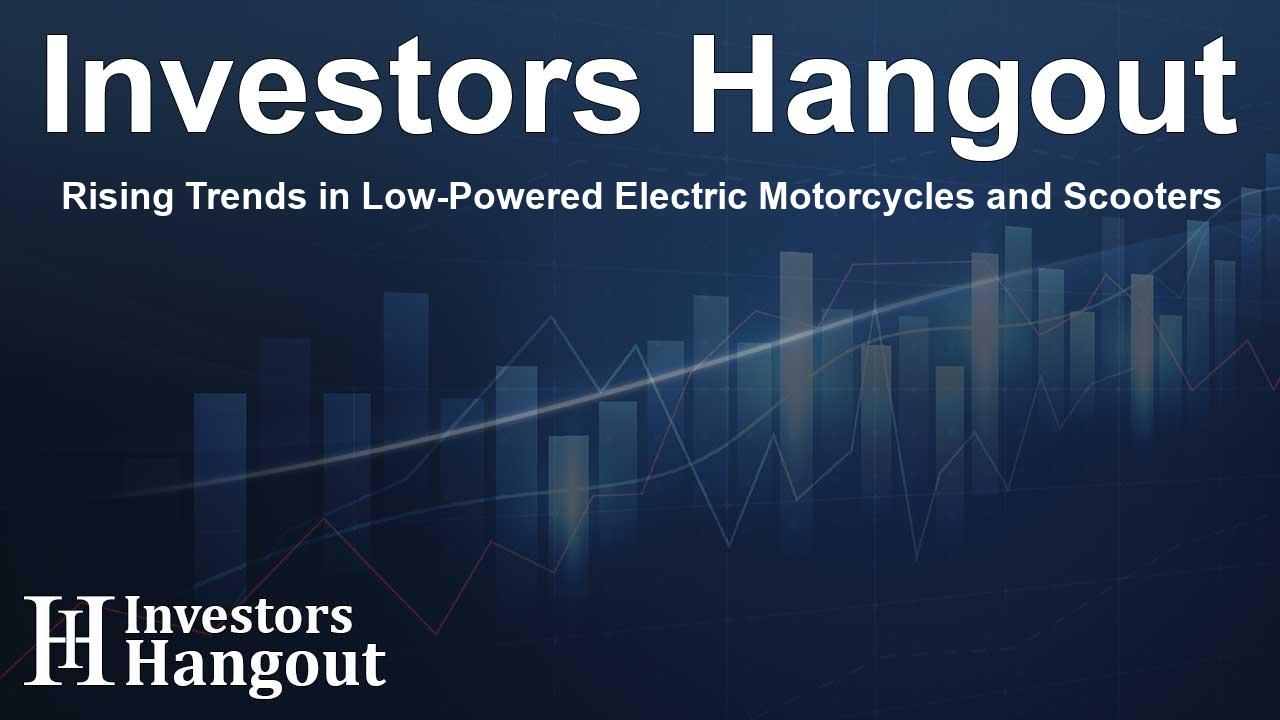Rising Trends in Low-Powered Electric Motorcycles and Scooters

Understanding the Low-Powered Electric Motorcycle and Scooter Market
The global market for low-powered electric motorcycles and scooters is on a remarkable growth trajectory, with estimates suggesting an increase by approximately USD 23.74 billion from 2024 to 2028. This growth is primarily fueled by a surge in government incentives and regulations that advocate the use of electric vehicles (EVs). The inclination towards advanced battery technologies is reshaping the landscape of this burgeoning market.
Key Drivers of Market Growth
Government Incentives and Rising Demand
As sustainability becomes increasingly prioritized globally, governments are stepping in with programs and incentives that encourage the adoption of electric two-wheelers. These initiatives are lifting the demand for low-powered electric motorcycles and scooters significantly, especially among environmentally conscious consumers. Alongside this, advancements in battery technology have led to improved performance, increased energy density, and shorter charging times, making these vehicles more appealing.
Innovations in Battery Technology
Innovations such as lithium-ion batteries are instrumental in enhancing the appeal of low-powered electric motorcycles and scooters. The latest lithium-ion systems offer superior energy density, allowing users to enjoy longer ranges and reliable performance on a single charge. Leading companies, such as Zero Motorcycles and Niu Technologies, are pushing the envelope on battery technology, contributing positively to consumer acceptance and market growth.
Growing Environmental Awareness
An upsurge in environmental awareness among consumers is further fueling the growth of this market. The shift towards eco-friendly transportation solutions is essential in today’s climate-conscious society. The economic factors, including the rising fuel prices, also play a significant role in steering consumers towards electric two-wheelers as a cost-effective alternative.
Challenges Facing the Market
Range Anxiety
Despite the advancements and appeal of low-powered electric motorcycles and scooters, significant challenges still loom large, one of the most critical being range anxiety. Many consumers worry about the limited range of these vehicles, which can inhibit their practical usage for longer commutes or extended travel. This apprehension can deter potential buyers, hindering the widespread acceptance of electric motorcycles and scooters in the market.
Production and Pricing Dynamics
Furthermore, challenges associated with vehicle production efficiency and raw material sourcing, particularly for battery-grade lithium, can influence pricing dynamics. Fluctuations in production costs and material availability could potentially affect profitability margins and the competitive positioning of manufacturers in the market.
Market Segmentation Insights
Segmentation of the low-powered electric motorcycle and scooter market occurs along various lines, including vehicle types, battery types, and geography. The primary vehicle types include electric scooters and electric motorcycles, both of which cater to a growing consumer base seeking energy-efficient transport. The battery type segmentation generally features lithium-ion, lead-acid, and other battery technologies, focusing on efficiencies that influence market adoption.
Regional Market Dynamics
The geographical segmentation covers various regions such as Asia Pacific, Europe, North America, South America, and the Middle East and Africa. Each of these regions demonstrates unique growth patterns and consumer preferences, further complicating market dynamics but also creating diverse opportunities for manufacturers.
Future Outlook for the Electric Mobility Sector
Entering the next market phase, manufacturers are expected to ramp up innovation, focusing on product improvements and new strategies to satisfy consumer demands. Insights gathered from ongoing research indicate an accelerated adoption rate of electric motorcycles and scooters, propelled by a combination of regulatory support, environmental awareness, and technological advancements.
Frequently Asked Questions
1. What is driving the growth of the low-powered electric motorcycle and scooter market?
The growth is primarily driven by government incentives, advancements in battery technology, and rising consumer demand for eco-friendly transportation options.
2. What are the major challenges facing the market?
Key challenges include range anxiety among consumers and material sourcing, particularly for battery-grade lithium, affecting production costs.
3. Who are the leading companies in this market?
Notable players include Ather Energy, BMW, and Zero Motorcycles, which are at the forefront of innovation in battery technology.
4. How are technological advancements influencing the market?
Technological advancements in battery systems enhance performance, efficiency, and affordability, significantly boosting market attractiveness.
5. What does the future look like for electric two-wheelers?
The future appears promising with anticipated market growth driven by sustainability initiatives and consumer interest in electric vehicles.
About Investors Hangout
Investors Hangout is a leading online stock forum for financial discussion and learning, offering a wide range of free tools and resources. It draws in traders of all levels, who exchange market knowledge, investigate trading tactics, and keep an eye on industry developments in real time. Featuring financial articles, stock message boards, quotes, charts, company profiles, and live news updates. Through cooperative learning and a wealth of informational resources, it helps users from novices creating their first portfolios to experts honing their techniques. Join Investors Hangout today: https://investorshangout.com/
Disclaimer: The content of this article is solely for general informational purposes only; it does not represent legal, financial, or investment advice. Investors Hangout does not offer financial advice; the author is not a licensed financial advisor. Consult a qualified advisor before making any financial or investment decisions based on this article. The author's interpretation of publicly available data shapes the opinions presented here; as a result, they should not be taken as advice to purchase, sell, or hold any securities mentioned or any other investments. The author does not guarantee the accuracy, completeness, or timeliness of any material, providing it "as is." Information and market conditions may change; past performance is not indicative of future outcomes. If any of the material offered here is inaccurate, please contact us for corrections.